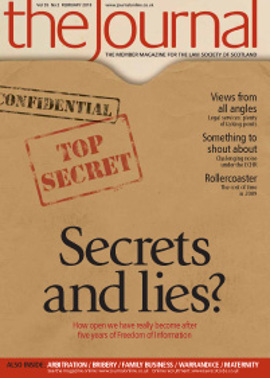Big decisions

Lawyers in the police station
The written reasons for the oral decision by the High Court on 22 October 2009 in HM Advocate v McLean [2009] HCJAC 97 were published on the SCS website on 15 December. The case is significant for a number of reasons: it was a rare (unique?) example of the reference of a devolution issue to the High Court by a sheriff at Forfar prior to a trial on indictment; it was heard by a bench of seven judges; and it provided valuable analysis of the decision by 17 judges of the Grand Chamber of the European Court of Human Rights in Salduz v Turkey [2008] ECHR 1542 (27 November 2008).
As is well known, ss 14 and 15 of the Criminal Procedure (Scotland) Act 1995 provide for a comprehensive system of pre-arrest detention, setting out the rights of the police and the suspect. But although a suspect is entitled to have the fact of his detention made known to a named solicitor, he has no right to legal advice before he is questioned, nor is his solicitor entitled to be present during a police interview. In the instant case, the suspect had received no such advice or services and, in the course of his interview, he made various potentially damaging admissions in respect of the matters under investigation.
On the authority of Paton v Ritchie 2000 JC 271 and the five-judge decision in Dickson v HM Advocate 2001 JC 203, the leading by the Crown of evidence of these admissions would be an act which would be Convention-compliant even although no lawyer was present when the admissions were made. But the Strasbourg court in Salduz was thought to have put all of this in doubt, having concluded in that case that violations of article 6(1) taken with article 6(3)(c) of the Convention had occurred, on account of the lack of legal assistance afforded to the accused while he was in police custody. In the result, a devolution issue minute was lodged in the instant case, and consequently many criminal trials in all parts of Scotland had to be put on hold while the reference was determined.
The questions resolved by the High Court were (a) whether the accused’s rights under article 6(1) and 6(3)(c) had been violated by the absence of legal representation from the moment of entry to the police station; and (b) assuming the Lord Advocate sought to rely on the admissions at trial, would she, by reason only of the accused not having had the opportunity of legal advice before being interviewed, be acting incompatibly with those articles and ultra vires in terms of s 57(2) of the Scotland Act 1998?
In seeking the answers to these questions, the High Court ruled that the ratio of Salduz was not as clear-cut as thought at first glance; indeed, two possible interpretations might be applied to what was said by the Grand Chamber in para [55] of its opinion. On the question of access to a lawyer as a requirement of a fair trial under article 6(1), perhaps the Chamber thought that every jurisdiction must, in order to comply with the Convention, have in place a system under which such access is ordinarily provided as from the first interrogation, whatever safeguards there might otherwise be for a fair trial; or perhaps the Chamber might be going no further than to say what it would generally expect: whether or not there was a violation would depend on the circumstances, including the arrangements made in the jurisdiction concerned, seen against the other guarantees in place there to secure a fair trial.
The High Court preferred the second of these alternatives, enumerating in detail the various guarantees of a fair trial in place in the Scottish system and expressing themselves as satisfied that these were sufficient. But the court also observed that even if this was to apply the wrong interpretation, all that was required by s 2(1)(a) of the Human Rights Act 1998 was that domestic courts should “take into account” judgments of the Strasbourg court. While the former courts should not lightly depart from a carefully considered decision of the latter, there was nothing in the reasoning in Salduz which indicated that any features of the Scottish system were considered by the Grand Chamber. Finally and in any event, how Salduz should be interpreted in Scotland was a matter for the High Court, within the margin of appreciation. In the result, the questions in the minute were both answered in the negative, the Scottish authorities were approved and the case was remitted to the sheriff for trial. It is understood that a further hearing is to be fixed on the issue of an appeal to the Supreme Court.
Punishment parts
The computation of the appropriate punishment part of a life sentence has regularly caused difficulty in recent years, both where the sentence is mandatory and in cases where it is discretionary. Guidelines on length and discount for cases of murder have now been set out by a bench of five judges in HM Advocate v Boyle, Maddock and Kelly [2009] HCJAC 89, 26 November 2009, while for discretionary life cases (and, it is thought, where an order for lifelong restriction (OLR) is imposed) the basic formula for computation is to be revisited sometime later this year by seven judges, when Petch and Foye v HM Advocate [2010] HCJAC 2, 8 January 2010, is fully argued.
The cases of Boyle and his co-accused Maddock, along with the separate case of Kelly, reached the High Court following a Crown appeal against punishment parts which had been imposed as part of mandatory life sentences and which were thought to be unduly lenient. In allowing all the appeals, the Court took the opportunity at the outset to disapprove of the suggestion made in earlier cases such as Walker v HM Advocate 2002 SCCR 1036 that 30 years was a virtual maximum punishment part; there might well be cases such as mass murders by terrorist action for which a longer period was appropriate.
But the appeal court in Walker also suggested that in the absence of significant mitigation, “most cases of murder” should attract a punishment part of 12 years or more, depending on the presence of one or more aggravating features, a suggestion with which the court in the instant case disagreed. In their unanimous opinion, the five judges thought that in a substantial number of cases, particularly where the offender had deliberately armed himself with (and used) a knife or other sharp instrument, a starting point of as low as 12 years would not be appropriate and should not be set in the absence of exceptional circumstances. In the current climate where knife crime is so prevalent, in cases of that kind the punishment period should normally be at least 16 years and may be significantly longer.
The court also took the opportunity to review the law and practice on sentence discounts for early pleas of guilty to murder. Having reviewed the Scottish authorities and the 2007 Guidelines issued for England & Wales by the Sentencing Guidelines Council, the court concluded that in murder cases the maximum discount to be applied to the punishment part should be about one sixth, reducing in some cases to nil, but never more than five years. In the result, Boyle and Maddock, who had been convicted after trial of a particularly horrific murder, had their punishment parts increased, in Boyle’s case from 15 to 20 years and in Maddock’s from 12 to 18. Kelly, who in 2002 had strangled a 64-year-old lady and then concealed her body under the floorboards until it was discovered in 2007, had his punishment part increased from 15 to 19 years; it would have been 22, but for a discount of a little more than one-eighth.
Discretionary life
By contrast, Petch and Foye raises a more fundamental issue: how is the punishment part to be computed in those very serious but non-murder cases which merit discretionary life or an OLR? Petch, convicted of two charges of raping children, appealed against a punishment part of 12 years imposed as part of a discretionary life sentence, while Foye received an OLR for the rape of an adult, appealing against a punishment part of nine years. Both seek to overturn Ansari v HM Advocate 2003 SCCR 347 as to the proper interpretation of the amended s 2(2) of the Prisoners and Criminal Proceedings (Scotland) Act 1993.
Ansari, which set out a complex formula for the initial computation, was a majority decision (Lord Reed having delivered a fully reasoned dissent). Now, there is little doubt that the law has got into something of a mess. It has to be said that this is largely due to the statutory wording itself. Just what factors must (and must not) be taken into account when fixing the punishment part? What weighting is to be given to the relevant factors? What comparisons (if any) are to be made with determinate sentences? What discounts are to be made and for what elements? Is it appropriate to second-guess the view of the Parole Board? These are just some of the points which await decision. In the provisional view of the three judges who remitted the case to seven of their colleagues, there are strong grounds to support the appellants’ contentions that Ansari was wrongly decided. But if so, what will be put in its place?
Charles Stoddart is a criminal law author and a former sheriff
In this issue
- More prejudicial than probative?
- Another age
- Resolution is the key
- On the record
- Chequing out
- ABS workout
- Know your books
- Family business and business families
- Forum of choice?
- A right to silence?
- What does it mean to be a solicitor?
- Traineeships down over 25%
- Law reform update
- From the Brussels office
- Appreciation: Alfred Phillips
- Appreciation: John Sinclair
- Training for success
- From here... to maternity
- Ask Ash
- The move in-house - do you have what it takes?
- Big decisions
- Balancing exercise
- Belief boundaries
- Details, details, details
- Scottish Solicitors' Discipline Tribunal
- Website review
- Book reviews
- Tougher regime
- No guarantees?
- Title insurance for insolvency practitioners
- PSG update






